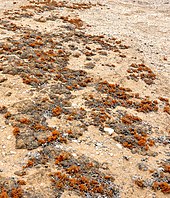
At 824,292 km2 (318,261 sq mi), Namibia is the world's thirty-fourth largest country. After Mongolia, Namibia is the second least densely populated country in the world. Namibia got its name from the Namib desert that stretches along the coast of the Atlantic. It is also known for its wildlife.

The Namib is a coastal desert in Southern Africa. According to the broadest definition, the Namib stretches for more than 2,000 kilometres (1,200 mi) along the Atlantic coasts of Angola, Namibia, and northwest South Africa, extending southward from the Carunjamba River in Angola, through Namibia and to the Olifants River in Western Cape, South Africa. The Namib's northernmost portion, which extends 450 kilometres (280 mi) from the Angola-Namibia border, is known as Moçâmedes Desert, while its southern portion approaches the neighboring Kalahari Desert. From the Atlantic coast eastward, the Namib gradually ascends in elevation, reaching up to 200 kilometres (120 mi) inland to the foot of the Great Escarpment. Annual precipitation ranges from 2 millimetres (0.079 in) in the aridest regions to 200 millimetres (7.9 in) at the escarpment, making the Namib the only true desert in southern Africa. Having endured arid or semi-arid conditions for roughly 55–80 million years, the Namib may be the oldest desert in the world and contains some of the world's driest regions, with only western South America's Atacama Desert to challenge it for age and aridity benchmarks.

The Namib-Naukluft Park is a national park in western Namibia, situated between the coast of the Atlantic Ocean and the edge of the Great Escarpment. It encompasses part of the Namib Desert, the Naukluft mountain range, and the lagoon at Sandwich Harbour. The best-known area of the park and one of the main visitor attractions in Namibia is Sossusvlei, a clay pan surrounded by dunes, and Sesriem, a small canyon of the Tsauchab. The desert research station of Gobabeb is situated within the park.

Swakopmund is a city on the coast of western Namibia, 352 km (219 mi) west of the Namibian capital Windhoek via the B2 main road. It is the capital of the Erongo administrative district. As of 2011, the town had 44,725 inhabitants and 196 km2 (76 sq mi) of land.

Biological soil crusts are communities of living organisms on the soil surface in arid and semi-arid ecosystems. They are found throughout the world with varying species composition and cover depending on topography, soil characteristics, climate, plant community, microhabitats, and disturbance regimes. Biological soil crusts perform important ecological roles including carbon fixation, nitrogen fixation and soil stabilization; they alter soil albedo and water relations and affect germination and nutrient levels in vascular plants. They can be damaged by fire, recreational activity, grazing and other disturbances and can require long time periods to recover composition and function. Biological soil crusts are also known as biocrusts or as cryptogamic, microbiotic, microphytic, or cryptobiotic soils.

The Namaqua chameleon is a ground-living lizard found in the western desert regions of Namibia, South Africa and southern Angola.
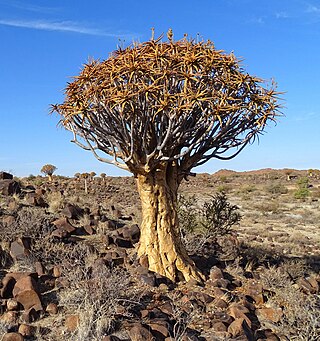
Aloidendron dichotomum, formerly Aloe dichotoma, the quiver tree or kokerboom, is a tall, branching species of succulent plant, indigenous to Southern Africa, specifically in the Northern Cape province of South Africa, and parts of Southern Namibia.
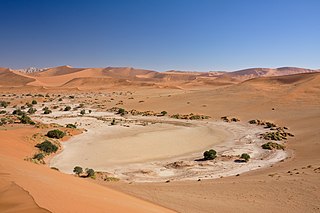
Sossusvlei is a salt and clay pan surrounded by high red dunes, located in the southern part of the Namib Desert, in the Namib-Naukluft National Park of Namibia. The name "Sossusvlei" is often used in an extended meaning to refer to the surrounding area. These landmarks are some of the major visitor attractions of Namibia.
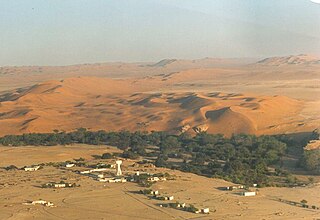
The Gobabeb Namib Research Institute, short: Gobabeb, is a centre for dry land training and research in Namibia. It is located in the Namib Desert, 120 kilometres (75 mi) south-east of Walvis Bay.

A fog desert is a type of desert where fog drip supplies the majority of moisture needed by animal and plant life. Examples of fog deserts include the Atacama Desert of coastal Chile and Peru; the Baja California desert of Mexico; the Namib Desert in Namibia; the Arabian Peninsula coastal fog desert; and a manmade instance within Biosphere 2, an artificial closed ecosphere in Arizona.
Uranium production is an important part of the African economy, with Niger, Namibia and South Africa creating up to 18% of the world's annual production. Many African countries produce uranium or have untapped uranium ore deposits.

The Namib Desert horse is a feral horse found in the Namib Desert of Namibia. It is the only feral herd of horses residing in Africa, with a population ranging between 90 and 150. The Namib Desert horse is athletic in appearance, resembling the European light riding horses from which it probably descends, and usually dark in color. Despite the harsh environment in which they live, the horses are generally in good condition, except during times of extreme drought. The horses have been the subject of several population studies, which have given significant insight into their population dynamics and ability to survive in desert conditions.

Namibia has one of the richest uranium mineral reserves in the world. There are currently two large operating mines in the Erongo Region and various exploration projects planned to advance to production in the next few years.
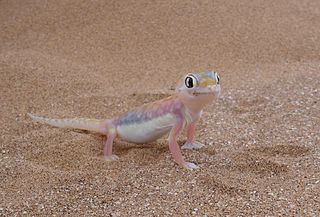
Pachydactylus rangei, the Namib sand gecko or Namib web-footed gecko, is a species of small lizard in the family Gekkonidae. It inhabits the arid areas of Angola, Namibia, and South Africa, and was first described in 1908 by Swedish zoologist Lars Gabriel Andersson, who named it after its finder, German geologist Dr. Paul Range.
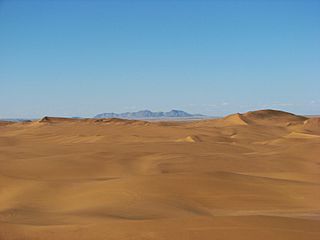
The Dorob National Park is a protected area in the Erongo region, along the central Namibian coast, which is 1,600 kilometres (990 mi) in length. It was gazetted as a national park under the Nature Conservation Ordinance No.4 of 1975 on 1 December 2010, and with Namib-Naukluft Park it covers an area of 107,540 square kilometres (41,520 sq mi).

The Husab Mine, operated under the Husab Uranium Project, is a uranium mine near the town of Swakopmund in the Erongo region of western-central Namibia. The mine is located approximately 5 kilometres (3.1 mi) south of the larger Rössing uranium mine and 45 kilometres (28 mi) from Walvis Bay. Swakop Uranium believes the Husab Mine has the potential to become the second largest uranium mine in the world after the McArthur River uranium mine in northern Saskatchewan, Canada and the largest open-pit mine on the African continent. Mine construction started in February 2013. The Husab Mine started production towards the end of 2016 after completion of the sulfuric acid leaching plant.
Toktokkies are various species of beetles that belong to the large Tenebrionidae family, also known as Darkling beetle. Toktokkies do not belong to a particular tribe or genus of Tenebrionids, but rather a selection of flightless species that make distinct noises by tapping on the ground with the abdomen. The Tenebrionidae family to which these beetles belong is quite large, with almost 3,500 species inhabiting Southern Africa. Nearly 200 species of Toktokkies inhabit the Namibia and 20 have adapted to the extreme temperatures of the Namib Desert. The most common Toktokkies in the Namib Desert are the Fog Basking beetle and the button beetle or trench-digging beetle.
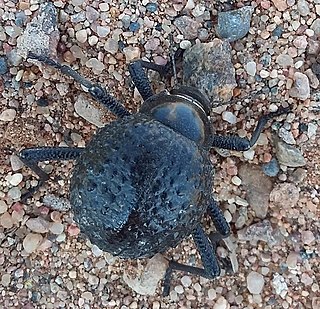
Physosterna cribripes, the desert toktokkie or woestyntoktokkie, is a flightless species of desert-dwelling darkling beetle or Tenebrionid found along the West coast of Namibia and Angola. This species has a body length of some 18.4 mm and a mass of 402 mg.
Xanthoparmelia serusiauxii is a species of foliose lichen in the family Parmeliaceae. Found in Namibia, it was formally described as a new species in 1986 by American lichenologist Mason Hale. The type specimen was collected by Hale from the Laguneberg Mountains, southeast of Cape Cross. There, it is common on dolerite boulders and small, flat pebbles. The specific epithet honours Emmanuël Sérusiaux, who, according to Hale, "was the first lichenologist to collect this unusual lichen in Namibia".
The Erongo Desalination Plant, also known as the Orano Desalination Plant, is a sea water desalination plant in Namibia. The facility was constructed between 2008 and 2010 by Orano Mining Namibia, which at the time was known as Areva Resources Namibia. The desalination plant was established to supply water to Orano’s Trekkopje Uranium Mine. At the time this plant was commissioned, it was the largest reverse osmosis desalination plant in Southern Africa.
